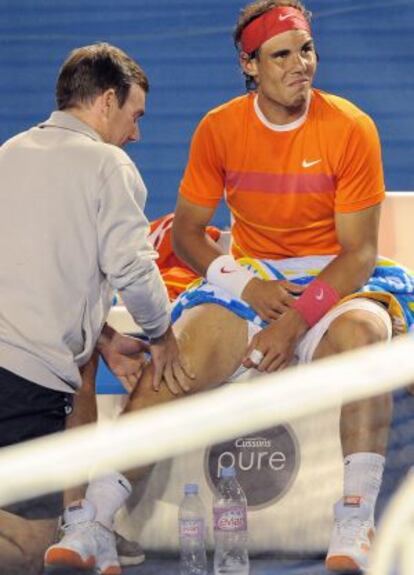The injection that cures it all?
Rafael Nadal has been using stem cell therapy to treat his knee and back injuries The promising but still experimental treatment has unclear long-term effects

Karim Khan, editor of the British Journal of Sports Medicine, recently tweeted the following imaginary conversation:
Player: Will stem cells cure my back pain?
Doctor: Lie = “Yes”
Doctor: Truth = “No idea, highly unlikely. Do you want to be a guinea pig?”
The Spanish tennis player Rafael Nadal would probably not find that funny, as he is a staunch believer in the curative powers of stem cells.
Yet the efficiency and safety of the treatment are still a matter of controversy in the scientific community, especially since The New York Times reported that baseball pitcher Bartolo Colon saved his career after getting his own bone marrow stem cells re-injected into his shoulder and elbow in May 2011.
The Mallorcan tennis champion turned to stem cell treatment in November 2013, after exhausting all other possibilities with platelet-rich plasma therapy. The procedure solved his knee problems for a year.
Nadal turned to stem cell treatment after exhausting all other possibilities
Nadal was so happy with the results that in November of this year he treated his back problems with the same therapy. After extracting the stem cells – which have the ability to turn into any required cell – from his own bone marrow, they were infiltrated into the athlete’s lumbar area.
Just like Nadal, a good number of NBA and US soccer players have submitted to similar treatments, which began experimentally in 2009. According to the 2014 World Stem Cell Report, around 700 clinics around the world now offer this technique, which is authorized by the World Anti-Doping Agency.
“My personal experience is very good, as is that of other people I know who use these techniques,” says Luis González Lago, a Spanish trauma surgeon who works for Baniyas, a soccer team in Abu Dabi.
González Lago, who used to work for the Atlético de Madrid handball team, is a great supporter of regenerative medicine, which includes stem cell therapy and the better known platelet-rich plasma treatment (which works by releasing growth factors that help heal muscles, ligaments and tendons).
“I think regenerative medicine is useful not just for sports trauma but also in degenerative processes of the joints, in bone defects, in slow healing of fractures, in maxillofacial surgery and in burn victims,” adds González Lago enthusiastically.
But critics are not quite as enthusiastic.
I can’t be in favor of stem cell treatment because it is still experimental therapy that is being practiced without scientific data”
“Evidently, I cannot be in favor of stem cell treatment because it is still a very experimental therapy that is being practiced without scientific data to support its benefits and long-term risks, which are unknown. It doesn’t seem serious to me,” says Juan Manuel Alonso, a member of the medical committee of the International Association of Athletics Federations (IAAF). “If athletes choose to be guinea pigs, fine, but they need to be aware that success is not likely, that the risks are unknown and that the costs are around €7,000 for one infiltration.”
Alonso also warns about the fact that clinics offering the treatment use the apparent miracles wrought on famous athletes as advertising for their products.
“We use adult stem cells that do not come from embryos, but from the patients themselves, which limits the possibility of side effects,” notes González Lago. “It is true that [the treatment] hasn’t been used long and that it is difficult to homogenize patients and cases into series, which means there is no published work in serious scientific publications unequivocally backing its usefulness. But I reiterate that my own experiences have been good.”
Tu suscripción se está usando en otro dispositivo
¿Quieres añadir otro usuario a tu suscripción?
Si continúas leyendo en este dispositivo, no se podrá leer en el otro.
FlechaTu suscripción se está usando en otro dispositivo y solo puedes acceder a EL PAÍS desde un dispositivo a la vez.
Si quieres compartir tu cuenta, cambia tu suscripción a la modalidad Premium, así podrás añadir otro usuario. Cada uno accederá con su propia cuenta de email, lo que os permitirá personalizar vuestra experiencia en EL PAÍS.
¿Tienes una suscripción de empresa? Accede aquí para contratar más cuentas.
En el caso de no saber quién está usando tu cuenta, te recomendamos cambiar tu contraseña aquí.
Si decides continuar compartiendo tu cuenta, este mensaje se mostrará en tu dispositivo y en el de la otra persona que está usando tu cuenta de forma indefinida, afectando a tu experiencia de lectura. Puedes consultar aquí los términos y condiciones de la suscripción digital.
Últimas noticias
Most viewed
- Alain Aspect, Nobel laureate in physics: ‘Einstein was so smart that he would have had to recognize quantum entanglement’
- Mexico’s missing people crisis casts a shadow over World Cup venue
- Why oil has been at the center of Venezuela-US conflicts for decades
- Trump clarifies who is ultimately in charge in Venezuela: ‘Me’
- Mexico seeks to shore up its defenses following US incursion in Venezuela









































